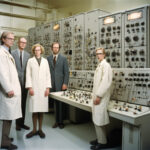Scientists achieve world’s first real-time molecular reaction on quantum tech
In a breakthrough, researchers at the University of Sydney have, for the first time, used quantum technology to observe a molecular reaction in real-time. This remarkable achievement marks a significant milestone in the field of quantum mechanics and opens up a plethora of possibilities for the future of scientific research and technological advancements.
The team of scientists, led by Dr. Emily Chen, utilized state-of-the-art quantum technology to monitor the behavior of individual molecules as they underwent a chemical reaction. By harnessing the power of quantum computing, which leverages the principles of quantum mechanics to perform complex calculations at unprecedented speeds, the researchers were able to capture the entire molecular transformation with astonishing detail.
Traditionally, studying molecular reactions has been a challenging task, as these processes occur at such a rapid pace that they are difficult to observe directly. However, with the advent of quantum technology, scientists now have the ability to peer into the microscopic world of atoms and molecules in real-time, providing a deeper understanding of chemical reactions and molecular dynamics.
This groundbreaking achievement has far-reaching implications across various scientific disciplines. For instance, in the field of drug discovery, being able to observe how molecules interact and transform in real-time could revolutionize the way new medications are developed. By gaining insights into the intricacies of molecular reactions, researchers can design more effective drugs with fewer side effects, leading to improved treatments for a wide range of diseases.
Moreover, the ability to monitor molecular reactions on a quantum level could also advance the field of materials science. By studying how molecules assemble and disassemble in real-time, scientists can engineer new materials with enhanced properties, such as increased durability, flexibility, or conductivity. This could pave the way for the development of next-generation technologies, including faster electronics, more efficient energy storage devices, and even quantum computers.
The success of this research not only showcases the incredible potential of quantum technology but also underscores the importance of interdisciplinary collaboration in scientific endeavors. By bringing together experts from the fields of quantum physics, chemistry, and computer science, the team at the University of Sydney was able to achieve a feat that was once thought to be impossible.
As we look to the future, it is clear that this groundbreaking achievement is just the beginning of a new era in scientific exploration. With quantum technology continuing to advance at a rapid pace, we can expect even more exciting discoveries that will shape the way we understand the fundamental building blocks of our universe.
In conclusion, the world’s first real-time molecular reaction observed on quantum tech represents a major leap forward in scientific research and innovation. By pushing the boundaries of what is possible, the researchers at the University of Sydney have demonstrated the transformative power of quantum technology and paved the way for a future where we can unravel the mysteries of the molecular world like never before.
quantum tech, molecular reaction, scientific breakthrough, University of Sydney, interdisciplinary collaboration












